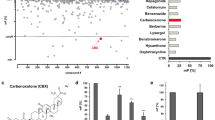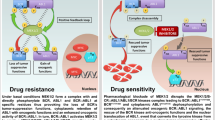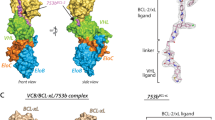Abstract
Mutations in the BCR-ABL1 kinase domain are an established mechanism of tyrosine kinase inhibitor (TKI) resistance in Philadelphia chromosome-positive leukemia, but fail to explain many cases of clinical TKI failure. In contrast, it is largely unknown why some patients fail TKI therapy despite continued suppression of BCR-ABL1 kinase activity, a situation termed BCR-ABL1 kinase-independent TKI resistance. Here, we identified activation of signal transducer and activator of transcription 3 (STAT3) by extrinsic or intrinsic mechanisms as an essential feature of BCR-ABL1 kinase-independent TKI resistance. By combining synthetic chemistry, in vitro reporter assays, and molecular dynamics-guided rational inhibitor design and high-throughput screening, we discovered BP-5-087, a potent and selective STAT3 SH2 domain inhibitor that reduces STAT3 phosphorylation and nuclear transactivation. Computational simulations, fluorescence polarization assays and hydrogen–deuterium exchange assays establish direct engagement of STAT3 by BP-5-087 and provide a high-resolution view of the STAT3 SH2 domain/BP-5-087 interface. In primary cells from chronic myeloid leukemia (CML) patients with BCR-ABL1 kinase-independent TKI resistance, BP-5-087 (1.0 μM) restored TKI sensitivity to therapy-resistant CML progenitor cells, including leukemic stem cells. Our findings implicate STAT3 as a critical signaling node in BCR-ABL1 kinase-independent TKI resistance, and suggest that BP-5-087 has clinical utility for treating malignancies characterized by STAT3 activation.
This is a preview of subscription content, access via your institution
Access options
Subscribe to this journal
Receive 12 print issues and online access
$259.00 per year
only $21.58 per issue
Buy this article
- Purchase on Springer Link
- Instant access to full article PDF
Prices may be subject to local taxes which are calculated during checkout







Similar content being viewed by others
References
Druker BJ, Guilhot F, O'Brien SG, Gathmann I, Kantarjian H, Gattermann N et al. Five-year follow-up of patients receiving imatinib for chronic myeloid leukemia. N Engl J Med 2006; 355: 2408–2417.
de Lavallade H, Apperley JF, Khorashad JS, Milojkovic D, Reid AG, Bua M et al. Imatinib for newly diagnosed patients with chronic myeloid leukemia: incidence of sustained responses in an intention-to-treat analysis. J Clin Oncol 2008; 26: 3358–3363.
Gorre ME, Mohammed M, Ellwood K, Hsu N, Paquette R, Rao PN et al. Clinical resistance to STI-571 cancer therapy caused by BCR-ABL gene mutation or amplification. Science 2001; 293: 876–880.
Shah NP, Nicoll JM, Nagar B, Gorre ME, Paquette RL, Kuriyan J et al. Multiple BCR-ABL kinase domain mutations confer polyclonal resistance to the tyrosine kinase inhibitor imatinib (STI571) in chronic phase and blast crisis chronic myeloid leukemia. Cancer Cell 2002; 2: 117–125.
O'Hare T, Shakespeare WC, Zhu X, Eide CA, Rivera VM, Wang F et al. AP24534, a pan-BCR-ABL inhibitor for chronic myeloid leukemia, potently inhibits the T315I mutant and overcomes mutation-based resistance. Cancer Cell 2009; 16: 401–412.
O'Hare T, Zabriskie MS, Eiring AM, Deininger MW . Pushing the limits of targeted therapy in chronic myeloid leukaemia. Nat Rev Cancer 2012; 12: 513–526.
Corbin AS, Agarwal A, Loriaux M, Cortes J, Deininger MW, Druker BJ . Human chronic myeloid leukemia stem cells are insensitive to imatinib despite inhibition of BCR-ABL activity. J Clin Invest 2011; 121: 396–409.
Hamilton A, Helgason GV, Schemionek M, Zhang B, Myssina S, Allan EK et al. Chronic myeloid leukemia stem cells are not dependent on Bcr-Abl kinase activity for their survival. Blood 2012; 119: 1501–1510.
Bewry NN, Nair RR, Emmons MF, Boulware D, Pinilla-Ibarz J, Hazlehurst LA . Stat3 contributes to resistance toward BCR-ABL inhibitors in a bone marrow microenvironment model of drug resistance. Mol Cancer Ther 2008; 7: 3169–3175.
Traer E, MacKenzie R, Snead J, Agarwal A, Eiring AM, O'Hare T et al. Blockade of JAK2-mediated extrinsic survival signals restores sensitivity of CML cells to ABL inhibitors. Leukemia 2012; 26: 1140–1143.
Schust J, Berg T . A high-throughput fluorescence polarization assay for signal transducer and activator of transcription 3. Anal Biochem 2004; 330: 114–118.
Farid R, Day T, Friesner RA, Pearlstein RA . New insights about HERG blockade obtained from protein modeling, potential energy mapping, and docking studies. Bioorg Med Chem 2006; 14: 3160–3173.
Rob T, Liuni P, Gill PK, Zhu S, Balachandran N, Berti PJ et al. Measuring dynamics in weakly structured regions of proteins using microfluidics-enabled subsecond H/D exchange mass spectrometry. Anal Chem 2012; 84: 3771–3779.
Copland M, Pellicano F, Richmond L, Allan EK, Hamilton A, Lee FY et al. BMS-214662 potently induces apoptosis of chronic myeloid leukemia stem and progenitor cells and synergizes with tyrosine kinase inhibitors. Blood 2008; 111: 2843–2853.
Hogge DE, Lansdorp PM, Reid D, Gerhard B, Eaves CJ . Enhanced detection, maintenance, and differentiation of primitive human hematopoietic cells in cultures containing murine fibroblasts engineered to produce human steel factor, interleukin-3, and granulocyte colony-stimulating factor. Blood 1996; 88: 3765–3773.
Kaeda J, Chase A, Goldman JM . Cytogenetic and molecular monitoring of residual disease in chronic myeloid leukaemia. Acta Haematol 2002; 107: 64–75.
Oh IH, Eaves CJ . Overexpression of a dominant negative form of STAT3 selectively impairs hematopoietic stem cell activity. Oncogene 2002; 21: 4778–4787.
Corvinus FM, Orth C, Moriggl R, Tsareva SA, Wagner S, Pfitzner EB et al. Persistent STAT3 activation in colon cancer is associated with enhanced cell proliferation and tumor growth. Neoplasia 2005; 7: 545–555.
Dengler MA, Staiger AM, Gutekunst M, Hofmann U, Doszczak M, Scheurich P et al. Oncogenic stress induced by acute hyper-activation of Bcr-Abl leads to cell death upon induction of excessive aerobic glycolysis. PLoS One 2011; 6: e25139.
Fletcher S, Singh J, Zhang X, Yue P, Page BD, Sharmeen S et al. Disruption of transcriptionally active Stat3 dimers with non-phosphorylated, salicylic acid-based small molecules: potent in vitro and tumor cell activities. Chembiochem 2009; 10: 1959–1964.
Zhang X, Yue P, Fletcher S, Zhao W, Gunning PT, Turkson J . A novel small-molecule disrupts Stat3 SH2 domain-phosphotyrosine interactions and Stat3-dependent tumor processes. Biochem Pharmacol 2010; 79: 1398–1409.
Fletcher S, Page BD, Zhang X, Yue P, Li ZH, Sharmeen S et al. Antagonism of the Stat3-Stat3 protein dimer with salicylic acid based small molecules. ChemMedChem 2011; 6: 1459–1470.
Hantschel O, Warsch W, Eckelhart E, Kaupe I, Grebien F, Wagner KU et al. BCR-ABL uncouples canonical JAK2-STAT5 signaling in chronic myeloid leukemia. Nat Chem Biol 2012; 8: 285–293.
Schafranek L, Nievergall E, Powell JA, Hiwase DK, Leclercq T, Hughes TP et al. Sustained inhibition of STAT5, but not JAK2, is essential for TKI-induced cell death in chronic myeloid leukemia. Leukemia 2014; e-pub ahead of print 12 May 2014; doi:10.1038/leu.2014.156.
Page BD, Fletcher S, Yue P, Li Z, Zhang X, Sharmeen S et al. Identification of a non-phosphorylated, cell permeable, small molecule ligand for the Stat3 SH2 domain. Bioorg Med Chem Lett 2011; 21: 5605–5609.
Zhang X, Yue P, Page BD, Li T, Zhao W, Namanja AT et al. Orally bioavailable small-molecule inhibitor of transcription factor Stat3 regresses human breast and lung cancer xenografts. Proc Natl Acad Sci USA 2012; 109: 9623–9628.
Page BDG, Croucher DC, Li ZH, Haftchenary S, Jimenez-Zepeda VH, Atkinson J et al. Inhibiting aberrant signal transducer and activator of transcription protein activation with tetrapodal, small molecule Src homology 2 domain binders: promising agents against multiple myeloma. J Med Chem 2013; 56: 7190–7200.
Resetca D, Wilson DJ . Characterizing rapid, activity-linked conformational transitions in proteins via sub-second hydrogen deuterium exchange mass spectrometry. FEBS J 2013; 280: 5616–5625.
Petzer AL, Eaves CJ, Lansdorp PM, Ponchio L, Barnett MJ, Eaves AC . Characterization of primitive subpopulations of normal and leukemic cells present in the blood of patients with newly diagnosed as well as established chronic myeloid leukemia. Blood 1996; 88: 2162–2171.
Donato NJ, Wu JY, Stapley J, Gallick G, Lin H, Arlinghaus R et al. BCR-ABL independence and LYN kinase overexpression in chronic myelogenous leukemia cells selected for resistance to STI571. Blood 2003; 101: 690–698.
Wu J, Meng F, Kong LY, Peng Z, Ying Y, Bornmann WG et al. Association between imatinib-resistant BCR-ABL mutation-negative leukemia and persistent activation of LYN kinase. J Natl Cancer Inst 2008; 100: 926–939.
Pene-Dumitrescu T, Smithgall TE . Expression of a Src family kinase in chronic myelogenous leukemia cells induces resistance to imatinib in a kinase-dependent manner. J Biol Chemistry 2010; 285: 21446–21457.
Hayette S, Chabane K, Michallet M, Michallat E, Cony-Makhoul P, Salesse S et al. Longitudinal studies of SRC family kinases in imatinib- and dasatinib-resistant chronic myelogenous leukemia patients. Leuk Res 2011; 35: 38–43.
Casetti L, Martin-Lanneree S, Najjar I, Plo I, Auge S, Roy L et al. Differential contributions of STAT5A and STAT5B to stress protection and tyrosine kinase inhibitor resistance of chronic myeloid leukemia stem/progenitor cells. Cancer Res 2013; 73: 2052–2058.
Quentmeier H, Eberth S, Romani J, Zaborski M, Drexler HG . BCR-ABL1-independent PI3Kinase activation causing imatinib-resistance. J Hematol Oncol 2011; 4: 6.
Neviani P, Harb JG, Oaks JJ, Santhanam R, Walker CJ, Ellis JJ et al. PP2A-activating drugs selectively eradicate TKI-resistant chronic myeloid leukemic stem cells. J Clin Invest 2013; 123: 4144–4157.
Zhang B, Li M, McDonald T, Holyoake TL, Moon RT, Campana D et al. Microenvironmental protection of CML stem and progenitor cells from tyrosine kinase inhibitors through N-cadherin and Wnt-beta-catenin signaling. Blood 2013; 121: 1824–1838.
McWeeney SK, Pemberton LC, Loriaux MM, Vartanian K, Willis SG, Yochum G et al. A gene expression signature of CD34+ cells to predict major cytogenetic response in chronic-phase chronic myeloid leukemia patients treated with imatinib. Blood 2010; 115: 315–325.
Nair RR, Tolentino JH, Hazlehurst LA . Role of STAT3 in transformation and drug resistance in CML. Front Oncol 2012; 2: 30.
Warsch W, Kollmann K, Eckelhart E, Fajmann S, Cerny-Reiterer S, Holbl A et al. High STAT5 levels mediate imatinib resistance and indicate disease progression in chronic myeloid leukemia. Blood 2011; 117: 3409–3420.
Bromberg JF, Wrzeszczynska MH, Devgan G, Zhao Y, Pestell RG, Albanese C et al. Stat3 as an oncogene. Cell 1999; 98: 295–303.
Nallar SC, Kalakonda S, Lindner DJ, Lorenz RR, Lamarre E, Weihua X et al. Tumor-derived mutations in the gene associated with retinoid interferon-induced mortality (GRIM-19) disrupt its anti-signal transducer and activator of transcription 3 (STAT3) activity and promote oncogenesis. J Biol Chem 2013; 288: 7930–7941.
Rossa C Jr, Sommer G, Spolidorio LC, Rosenzweig SA, Watson DK, Kirkwood KL . Loss of expression and function of SOCS3 is an early event in HNSCC: altered subcellular localization as a possible mechanism involved in proliferation, migration and invasion. PLoS One 2012; 7: e45197.
Hartman ZC, Yang XY, Glass O, Lei G, Osada T, Dave SS et al. HER2 overexpression elicits a proinflammatory IL-6 autocrine signaling loop that is critical for tumorigenesis. Cancer Res 2011; 71: 4380–4391.
Koskela HL, Eldfors S, Ellonen P, van Adrichem AJ, Kuusanmaki H, Andersson EI et al. Somatic STAT3 mutations in large granular lymphocytic leukemia. N Engl J Med 2012; 366: 1905–1913.
Couronne L, Scourzic L, Pilati C, Della Valle V, Duffourd Y, Solary E et al. STAT3 mutations identified in human hematological neoplasms induce myeloid malignancies in a mouse bone marrow transplantation model. Haematologica 2013; 98: 1748–1752.
Cao X, Tay A, Guy GR, Tan YH . Activation and association of Stat3 with Src in v-Src-transformed cell lines. Mol Cell Biol 1996; 16: 1595–1603.
Hu Y, Swerdlow S, Duffy TM, Weinmann R, Lee FY, Li S . Targeting multiple kinase pathways in leukemic progenitors and stem cells is essential for improved treatment of Ph+ leukemia in mice. Proc Natl Acad Sci USA 2006; 103: 16870–16875.
Samanta AK, Chakraborty SN, Wang Y, Kantarjian H, Sun X, Hood J et al. Jak2 inhibition deactivates Lyn kinase through the SET-PP2A-SHP1 pathway, causing apoptosis in drug-resistant cells from chronic myelogenous leukemia patients. Oncogene 2009; 28: 1669–1681.
Darnell JE Jr . Transcription factors as targets for cancer therapy. Nat Rev Cancer 2002; 2: 740–749.
Levy DE, Darnell JE Jr . Stats: transcriptional control and biological impact. Nat Rev Mol Cell Biol 2002; 3: 651–662.
Song H, Wang R, Wang S, Lin J . A low-molecular-weight compound discovered through virtual database screening inhibits Stat3 function in breast cancer cells. Proc Natl Acad Sci USA 2005; 102: 4700–4705.
Schust J, Sperl B, Hollis A, Mayer TU, Berg T . Stattic: a small-molecule inhibitor of STAT3 activation and dimerization. Chem Biol 2006; 13: 1235–1242.
Pan Y, Zhou F, Zhang R, Claret FX . Stat3 inhibitor Stattic exhibits potent antitumor activity and induces chemo- and radio-sensitivity in nasopharyngeal carcinoma. PLoS One 2013; 8: e54565.
Fuh B, Sobo M, Cen L, Josiah D, Hutzen B, Cisek K et al. LLL-3 inhibits STAT3 activity, suppresses glioblastoma cell growth and prolongs survival in a mouse glioblastoma model. Br J Cancer 2009; 100: 106–112.
Zhang X, Sun Y, Pireddu R, Yang H, Urlam MK, Lawrence HR et al. A novel inhibitor of STAT3 homodimerization selectively suppresses STAT3 activity and malignant transformation. Cancer Res 2013; 73: 1922–1933.
Dave B, Landis MD, Tweardy DJ, Chang JC, Dobrolecki LE, Wu MF et al. Selective small molecule Stat3 inhibitor reduces breast cancer tumor-initiating cells and improves recurrence free survival in a human-xenograft model. PLoS One 2012; 7: e30207.
Acknowledgements
We acknowledge Johanna Estrada, Kevin Gantz, Hannah Redwine, Hillary Finch and Anthony Iovino for technical assistance, and Kimberly Snow and Candice Ott for clerical assistance. We thank Dr Rob C Laister and the Minden group for providing full-length purified STAT3 protein and a STAT3 expression construct. We also thank Dr Il-Hoan Oh, Catholic University of Korea, for providing a dominant-negative STAT3 construct. We acknowledge support of funds in conjunction with grant P30 CA042014 awarded to the Huntsman Cancer Institute, and 5P30CA042014-24 awarded to The University of Utah Flow Cytometry Facility. MWD was supported by grants from the National Institutes of Health (NIH), including HL082978-01, CA046939-23 and R01CA178397, was a Scholar in Clinical Research of the Leukemia & Lymphoma Society (LLS; 7036-01), and is funded by LLS grant SCOR7005-11. AME was supported by a NIH T32 training grant (CA093247), followed by an LLS Career Development Award (5090-12), and is currently funded through a Scholar Award from the American Society of Hematology. AME also acknowledges support from the NIH Loan Repayment Program. This research was supported in part by the LLS Screen-to-Lead Program awarded to MWD, TO and PTG (SLP-8002-14). TO is supported by NIH grant R01CA178397. RB acknowledges a petascale computing Research Award at the Extreme Science and Engineering Discovery Environment (XSEDE) supercomputers (TG-CHE120086). XSEDE is supported by National Science Foundation grant OCI-1053575. RB acknowledges startup funds from the Department of Medicinal Chemistry, and technical support and computing allocations at the Center for High Performance Computing, The University of Utah. RM was supported by grant SFBF47 from the Austrian Science Fund (FWF). PTG and BDGP are supported by the National Sciences and Engineering Research Council. PTG is also supported by the Canadian Breast Cancer Research Foundation. DJW is supported by a Discovery Grant (257588) and by an Ontario Ministry of Research and Innovation Early Researcher Award.
Author information
Authors and Affiliations
Corresponding author
Ethics declarations
Competing interests
MWD is a consultant for BMS, Novartis, ARIAD, Pfizer and Incyte. His laboratory receives research funding from BMS and Novartis.
Additional information
Supplementary Information accompanies this paper on the Leukemia website
Supplementary information
Rights and permissions
About this article
Cite this article
Eiring, A., Page, B., Kraft, I. et al. Combined STAT3 and BCR-ABL1 inhibition induces synthetic lethality in therapy-resistant chronic myeloid leukemia. Leukemia 29, 586–597 (2015). https://doi.org/10.1038/leu.2014.245
Received:
Revised:
Accepted:
Published:
Issue Date:
DOI: https://doi.org/10.1038/leu.2014.245
This article is cited by
-
Unraveling the complexity of STAT3 in cancer: molecular understanding and drug discovery
Journal of Experimental & Clinical Cancer Research (2024)
-
“Combination treatments of imatinib with astaxanthin and crocin efficiently ameliorate antioxidant status, inflammation and cell death progression in imatinib-resistant chronic myeloid leukemia cells”
Molecular Biology Reports (2024)
-
The importance of personalized medicine in chronic myeloid leukemia management: a narrative review
Egyptian Journal of Medical Human Genetics (2023)
-
AMPK-induced novel phosphorylation of RUNX1 inhibits STAT3 activation and overcome imatinib resistance in chronic myelogenous leukemia (CML) subjects
Cell Death Discovery (2023)
-
Non-coding RNAs in leukemia drug resistance: new perspectives on molecular mechanisms and signaling pathways
Annals of Hematology (2023)



